I admit, I have a couple of non-standard hobbies. The one that gets the highest eyebrow raise, is, of course, chasing trains. But I’m not a generalist, I tend not to chase any train, there has to be something special about it: a unique, rarely-seen train (I once tried to follow the Union Pacific Heritage fleet when it came to Calgary numerous years ago), the location through which its running (such as Eagle Pass), even it’s colour (the all-red CP or Canadian Tire TEUs, for example). But if it’s a steam train, the rest doesn’t matter, it’s just a gimme that I’ll follow.
For the last two years, Canadian Pacific has been fixing up their steam locomotive, #2816. Though they put it back on the rails way back in 2001, previous heads of the company simply didn’t see the value in running a steam program, so mothballed it since the early 2010s. It’s steam ticket expired and the maintenance bills grew. But a new CEO, Keith Creel, saw value in attracting attention to something that most people ignore (or curse as it blocks their commute) and resurrected the locomotive, just in time for a merger with Kansas City Southern.
And so it became that The Empress ceased being a dark little secret and started to become a star. Certainly here in Calgary, there were rumours extensive that the locomotive would be running again, soon. Things took a bit longer than expected – steam locomotives are notoriously difficult to repair, especially if you’re working on a tight budget – but after several unpublicized but heavily socially-media’ed test runs about the province, CPKC (as the new company) announced the Final Spike Steam Tour, where – for the first known time – a steam locomotive would traverse North America, from Canada to Mexico. And it would start in CPKC’s Canadian headquarters, Calgary. As soon as the dates were announced, even without details, I booked the days off.
As details became more clear, I started planning. Notably: where to take pictures. The train would run from Calgary to Medicine Hat on one of two CPKC lines that run easterly from Calgary, the Brooks Subdivision. (The other line, the Aylderside subdivision, runs to Lethbridge; although to be really pedantic, subdivisions “run” east to west.) The last time I chased CP 2816 on the Brooks sub, I got as far as Brooks before giving up, mostly because there are huge sections of the line that are too far from the highway to be usable, especially if the train is running at track speed.
The day finally came – my first day off, two days ago – and I headed over to the first public event at CPKC’s headquarters in Ogden (one of Calgary’s neighbourhoods). The Ogden Shops had once been the western repair centre for CP’s fleet, the site covered in massive buildings a lattice of decaying tracks. Shortly after Hunter Harrison became CEO, however, he ordered the site renovated, with nearly all tracks pulled, a few buildings demolished, a few more buildings erected, transforming the site from an eyesore of railway days past to a modern home of a modern company. For folks like me, it feels like more of a loss than a gain – like finding abandoned railway lines in the prairies that had once served the small towns, now disappearing into the grasslands from which they had sprung barely a century and a half earlier.
At the far west end, down a road that wound along the edge of the campus, sat 2816, gently steaming, awaiting the crowds. I arrived nearly an hour early, partly as I’d misjudged the time it would take to get there, and mostly out of excitement. I did check with the CP Police on site to make sure I wouldn’t run afoul of any rules. (Always be nice to the railway police. They have all the same power of the RCMP within a mile of the railway lands.)
I still remember the first time I saw 2816 in Field, BC, on her Inaugural Run to Calgary. It was the first time I’d gotten a good look at the locomotive (I would get better ones later) and was amazed at the work they’d done. What CP 2816 had been through in the years since I’d last seen it run and two days ago, I have only heard rumour, most of which was “tucked in a corner and mostly forgotten except by a dedicated few”, but it was clear that the dedicated few had done much, for I think the locomotive gleamed more than it ever had before.
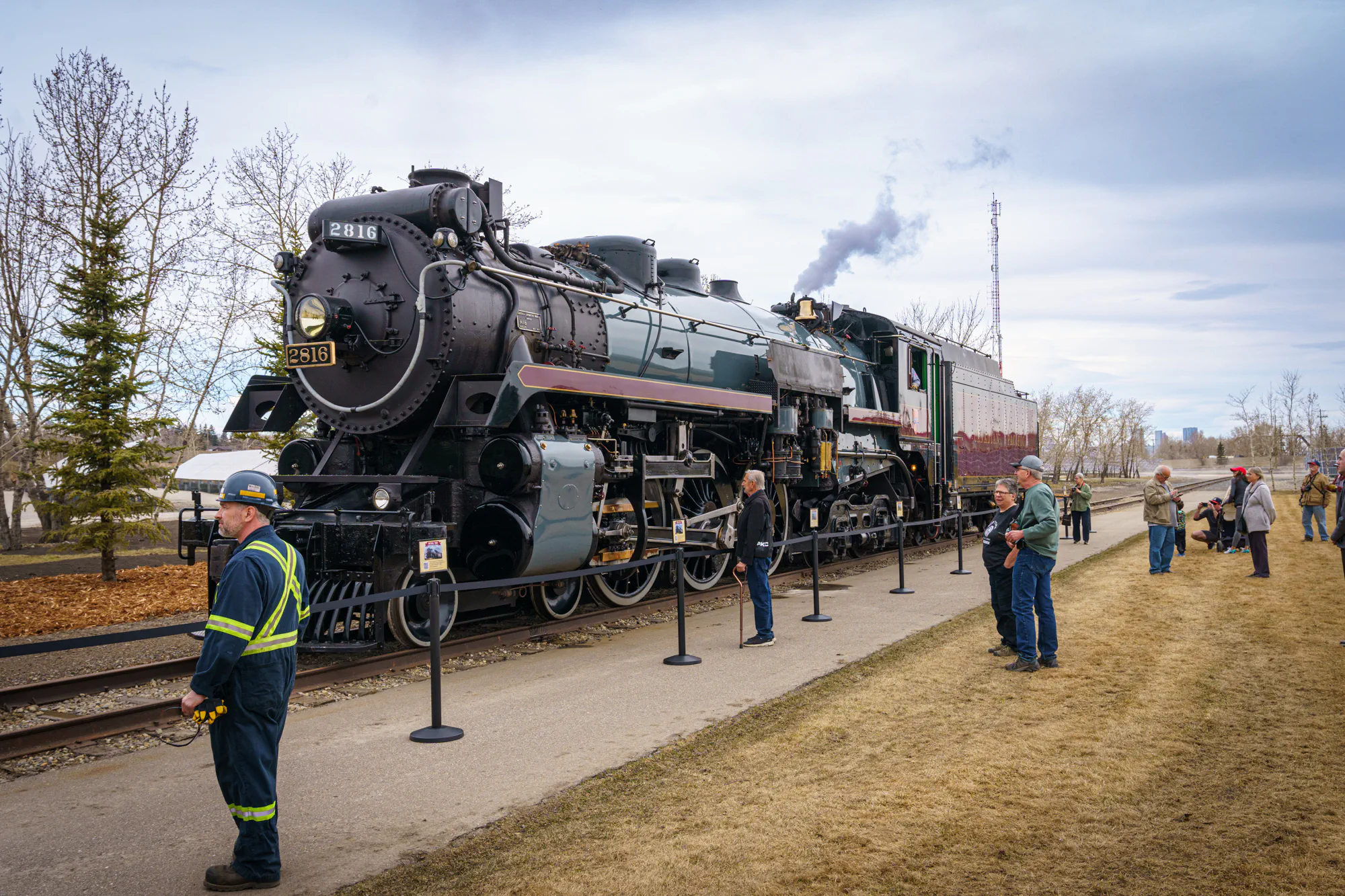
It was good to hear the clunking and breathing as the steam flowed and the pumps ran. The only drawback was the whine of the dynamo, needed to provided electrical power in the cab for lights and electronics (one of the major upgrades was setting up 2816’s cab to control the diesel locomotives that trail behind); the dynamo overpowered some of the other sounds.
The event, such as it was, was low-key: the locomotive, a modest museum on wheels, and Puffing Belly, a road-borne train for kids that rolled around the parking lots. Still, it attracted quite the crowd, one of whom looked really familiar: Clint, my friend and realtor’s husband. Surprised to see each other, I learned that he’d decided to move on from the Calgary Police Service, wanting to go corporate, but still wanted to be a cop. In Canada, there aren’t many options, and the CPKC Police were looking. I apparently have a friend in a fairly good place.
After wandering the grounds a bit (which did bring back some memories of how it once was), finding engines #29 and #1400 near the old Power House, I decided it was time to leave. And that’s when I realized the mistake of the event – getting into the site took 2 minutes; getting out took nearly an hour because CPKC hadn’t planned for traffic.
The real event was today, Friday, as the train departed on its journey. According to Clint, it had been scheduled for 8:50 am. After my experience at Ogden on Wednesday, I decided that I would start my chase at a slightly more accessible location to the south, just off Barlow Trail, where the line cuts under the road as it turns east. Following the line within Calgary is difficult due to the road layouts, so it was the best possible location to then head south to Hwy 22X, which does due east.
I arrived at a little after 8:20am to find that the exact location I had hoped to set up was, in fact, the offramp for the northbound Barlow, something I hadn’t realized looking at Google Maps. As it stands, it was fine; a dozen metres away, I pulled over at the edge of a parcel of open land next to the tracks, and started considering my next moves, noting the parked container train on the side track, blocking any potential view of the soon-to-come steam train.
A knock at my window immediately had me wondering if I was already in trouble. But it turned out to be a woman who had spotted a train enthusiast (me) and had some questions. It would be the first of many times today I would be able to help someone else understand what was expected, based on the information that I had. I was in the midst of explaining that I was considering heading east already, as the train was due to depart soon and there was another train blocking view, when the blocking train suddenly started moving. It was time to set up.
I had two cameras with me: my Sony A7 III, which is my primary photographic camera, and my old Canon 70D, which I decided would be my video camera (it’s not the highest resolution, but it would more than suffice). After pacing back and forth on the land a bit, I put the video camera closer to the tracks on the bend, then moved back towards the road for a longer view down the tracks. Soon, others started to get out of their cars and set up in their preferred places. Some had large, expensive cameras, some nothing but their own eyes. One guy had a radio scanner, which at least gave us some sense of what was going on a mile up the tracks, some of which was supplemented by Facebook Messages chats I was following.
And we waited. 8:50 came and past on the cold northerly breeze that was starting to cut through my layered outfit that had been set for a warmer, sunnier weather prediction. A family from Fernie, their 10-ish year-old son inventing game after game to idle the time, chatted with me as we waited and waited. The mother soon became desperate that there was no nearby toilet nor safe bush to hide behind. The son then declared “uh oh” as another westbound train slowly slipped out of the intermodal yard’s passing track, the main line that 2816 would presumably later come down.
What was going on?
An hour later, we were all wondering. There were about a hundred people scattered about a 200 metre stretch, all staring northwards in hopes of seeing moving steam. The radio chatter hinted at a yardmaster who was keen to get the steam train moving to clear his line, the Messenger chats suggested the train hadn’t yet left Ogden. We continued to shiver.
Finally, news came that the train had been cleared to switch onto the main line. This was a blocking move, there being only a single track at that point, so the train had to move. And yet, still we waited. And waited.
Nearing 10:00am, we heard the whistle from a mile away – one point of the whistle was to be heard at a distance – and we all prepared. I suspected (right, as it seemed) that the train would not race past, as the track was part of the yards and trains don’t move through there particularly quickly. Soon, we could see the moving cloud, the tell-tale sign of a steam train in cold weather. Suddenly, the shivering dissipated as the excitement grew. The came the moving light, the unmistakable grey and red livery, the blackness, and the whistle grew closer. Everyone’s carefully-chosen positions shifted as we all discovered that where we were wasn’t quite what we wanted.
At about 30 km/h and with a hint of colour in the steam exhaust, the train trundled past on the siding track closest to us, a clear decision by the railway to make sure that the first fans of the day got a fantastic view. CP 2816’s engineer waved proudly as the locomotive chugged, followed by the locomotive’s tender and two additional water cars, the day-glo green of CP 1001 (the prototype hydrogen locomotive that would go to Medicine Hat before dropping off), FP7As CP 1401 and 1407 (vintage diesels also providing backup power), then the long Tuscan red Royal Canadian Pacific set, including the Sanford Fleming observation car at the end.
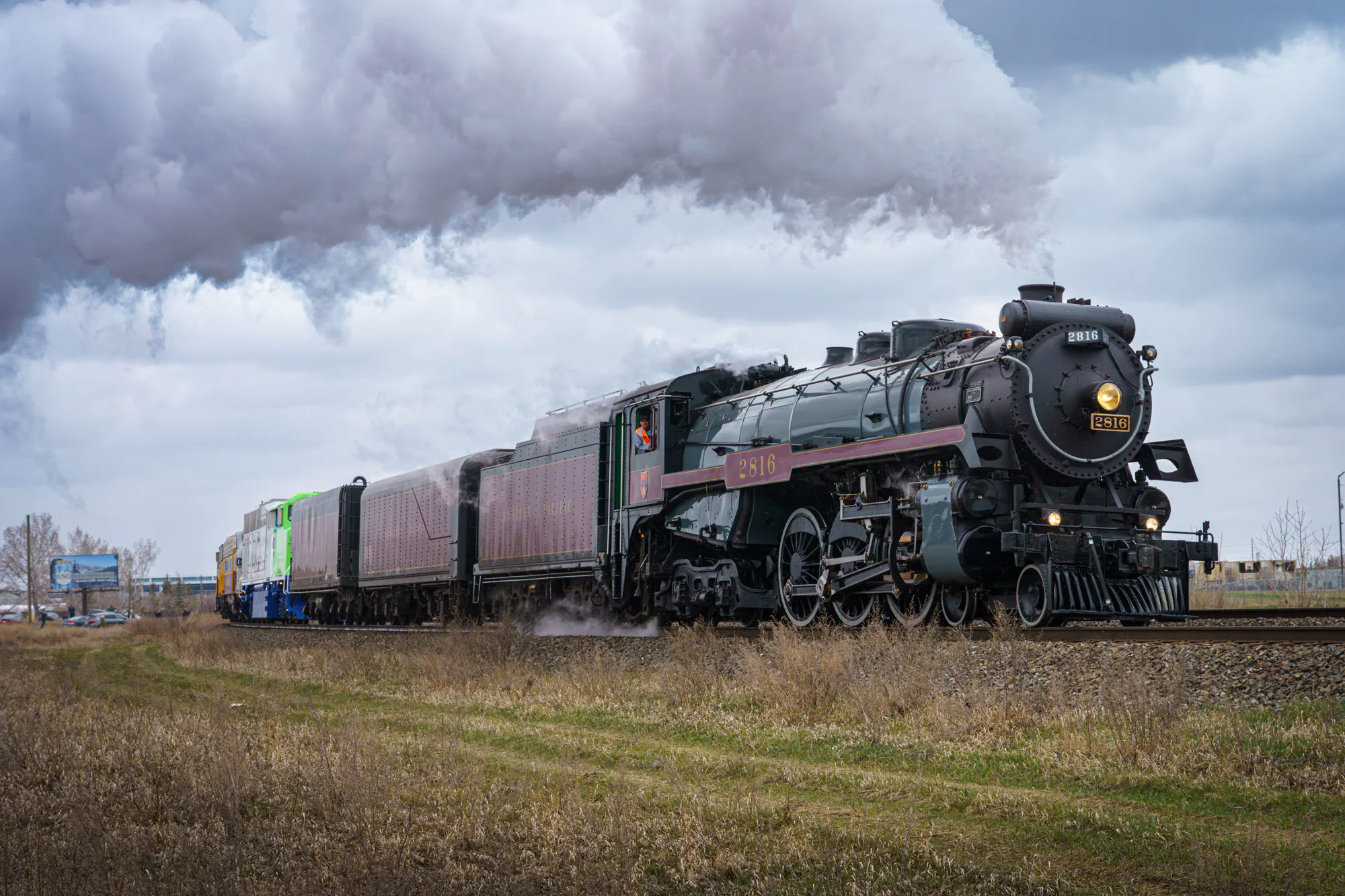
As it passed away, I smiled and chuckled: “The chase is on!” It’s been over a decade since my last chase, and I was looking forward to this.
Packing my gear in the car, I took advantage of someone else’s hesitation to pull a u-turn onto Shepard heading south onto Barlow, catching one red light at the Glenmore Inn and Convention Centre (which was the nearest toilet I could offer to the desperate mother), before hitting the Deerfoot south. I was running on the two shorter sides of a right triangle, the train on the hypotenuse. My only hope was that the intermodal yard had a limit that would let me get ahead.
My hope was, thankfully, fulfilled as I passed the corner where Stoney Trail turns north and I headed out of the city limits. Though steam clouds rose from various industrial plants, only one was moving. And it wasn’t moving very quickly … yet. Passing anyone on Hwy 22X would have been challenging – it’s a mere two-lane road (with a 100 km/h limit) with a lot of truck traffic. Thankfully, I wasn’t the only one in a rush.
Fans were already decorating the bridge at Indus that takes the 22X from the south side of the tracks to the north. I had marked it as my first potential stop out of the city, but Google Street View had shown me that the view wasn’t fantastic, so I’d left it as a second-tier option, the same with the first road after the bridge.
I went with a stop on Hwy 797, just south of 22X, west of Dalemead. Quite a few people had already set up when I arrived. The train’s lights were clear in the distance, so I quickly set up the video camera on the north side of the track, then headed off to take my pictures on the south side (the hogger’s side of the train). It arrived moments later, already having picked up considerable speed leaving Calgary. It was clear that the train was not going to take the Brooks sub leisurely.

On Wednesday, I had learned that the train would stop briefly outside of the Carseland for a quick mechanical inspection. It’s a good distance to let the running gear warm up enough to ensure that things are working as expected. But the stop would not be long. That said, I made the snap decision to roll into Carseland, just in case there was a good view. The extra ten minutes were a bit of a waste as the train had been parked some distance to the west, inaccessible by any road. I opted not to join the plethora of fans assembling for the run-by, and continued onto Hwy 24 eastwards to Hwy 817, then north to the crossing.
Quite a few were already there, as well. The chatter suggested that the train had started moving again; I hurried to set up. The road was raised above the fields, offering us a long view of the approaching train onto the long curve before it crossed over the road. Scooping the cameras up, I bolted to the car before the crossing’s arms had lifted, and turned out onto the road before a couple of others could, forcing my way into the quickly-growing line of cars heading onto the chase.
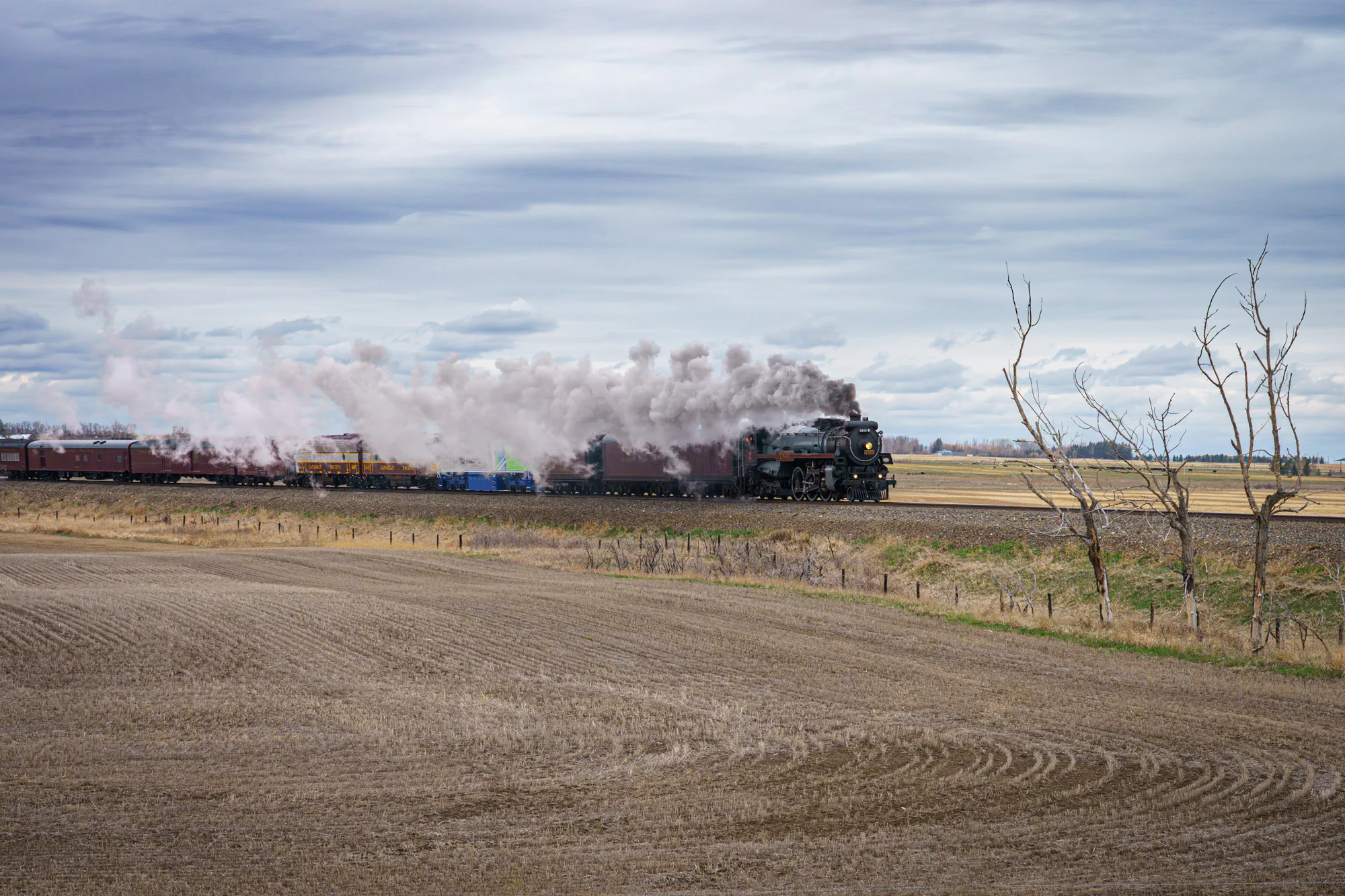
We turned east onto Hwy 901 (which 22X effectively turns into when it hits Hwy 24), all of us racing as fast as we could to get to the next viable stop. Only a couple of kilometres down the road, both the CP line and Hwy 901 enter the Siksika Nation, which imposes a certain level of requirement: you cannot go too quickly (70 km/h, thank you) and you need to watch for pedestrians on the road. I can’t say any of us followed the limit, but I also can’t really confirm it as my biggest concern was keeping pace with the people in front.
For a brief period, we could pace the train as it plied ahead, the rest of us on the road. But the line predates the road, one following the terrain, the other a restricted budget, so our ways parted not long after.
As we approached Bartstow, the first of two crossings, I snickered at the line of cars. There about 20 in front of me, easily 50 behind me. In all my years of chasing, I’d never seen so many people out. If anything, CPKC had succeeded in publicizing this journey. A quick view at Bartstow confirmed a previous decision not to stop, it wasn’t a particularly nice view, and it would put me far behind the train. I pushed on, barely slowing. Not 100 metres further, the lights on the crossing lit up.
Now we had a problem: the road continued to head south through the Siksika’s lands, which at this point have several groupings of houses and other buildings, all of which could have hidden the Reservation Police, who would be none-too-happy with the pace we were all setting. Even the CPKC Police, in their unmarked but well-lit SUVs, had difficulty passing us as they raced to the next crossing to ensure safety.
As the crossing on the far side of Gleichen came into view, I held my breath. I had no idea where the train was. Although CPKC had released a tracker on their website, it was unusable as a chasing tool, there was no way for me to know as a solo driver if I was in a good position. Given that there was still a crowd at the crossing, however, it seemed reasonable that we’d somehow managed to beat it. As I pulled in, I could see the lights cresting over a rise in the land. I had, at most, 30 seconds.
2816 might be 97 years old, but it’s still very spry.
I unsafely leapt from the car, onto the road, narrowly missing a truck. I didn’t bother with my video camera. One guy behind me, travelling with others, nearly tripped across the road to get in place.
Ding ding ding. Whistle: short short long short. Snap snap snap. Run back to car, start, cut a few people off, tear onto Hwy 1, continue east.
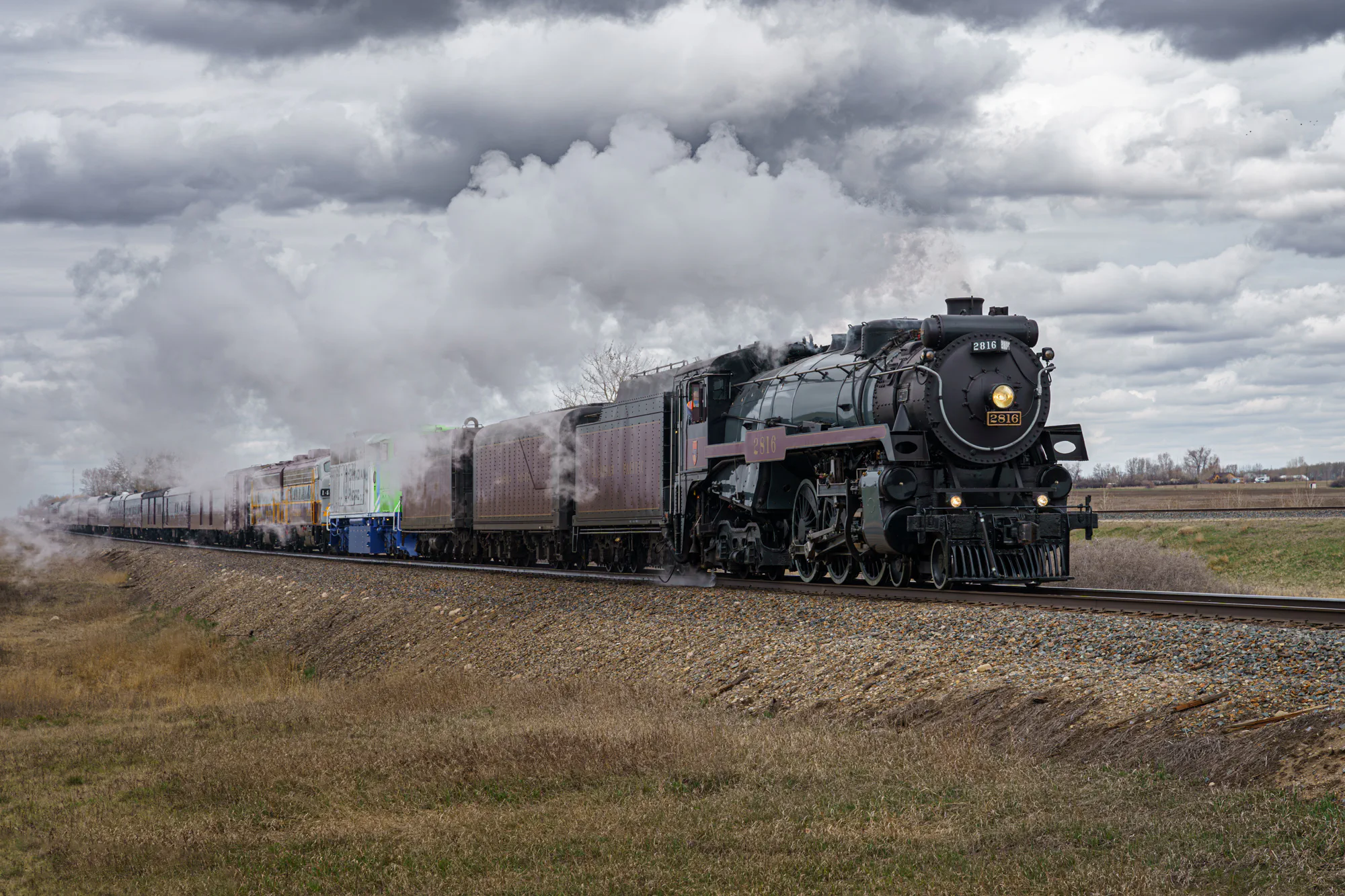
From Gleichen to just east of Bassano, the tracks and Hwy 1 deviate quite a bit, and diving in and out with hopes of keeping pace is really difficult. I had marked a potential stop at Crowfoot, just south of the junction with Hwy 56, but with the train at track speed, I didn’t want to miss my chance at my preferred spot, Lathom. Which is where I went next.
Lathom is one of many named places along the CP lines that had virtually nothing remaining. Once upon a time, there had been a station, maybe even an elevator. Today, it’s a couple of homes, the name remaining only as a geographic marker (even Google thinks it’s just a part of Bassano). The reason I wanted Lathom is because of the Spring Hill Canal, one of the many irrigation canals that cross southern Alberta – another legacy of Canadian Pacific from a century earlier.
Someone was already waiting. The man, much younger than me, had been there since 9:30, not sure when the train was due to come. He was relieved with my arrival that the train would not be far behind. As I set up my video camera to focus on the short bridge over the canal, we discussed our plans. Like me, he had done his research online, trying to find the best spots to catch a good picture. We talked about whether Casslis (an overpass to the west of Brooks) or the Brooks Viaduct would be a better view; I said he had to pick one, as there was no chance of getting both at the speed the train was running.
Another man walked up. A pipeline worker (possibly an inspector), he commented that he’d seen quite a few people with cameras standing next to the railway and wondered what was up. We told him a steam train was due by any moment. He nodded, thought about it, then said: “Maybe I’ll stick around.”
A moment later, we could hear the distance whistle. We took our positions. I heard a drone take to the air. Only a half dozen of us at Lathom, we were ready. The track at this point is nearly dead-straight and the engineers had pushed 2816 to its top speed, 50 mph (yes, railways still do Imperial; Lathom is Milepoint 90.3 out of Medicine Hat), whistle in full use as it roared past, over the bridge, and out of sight.
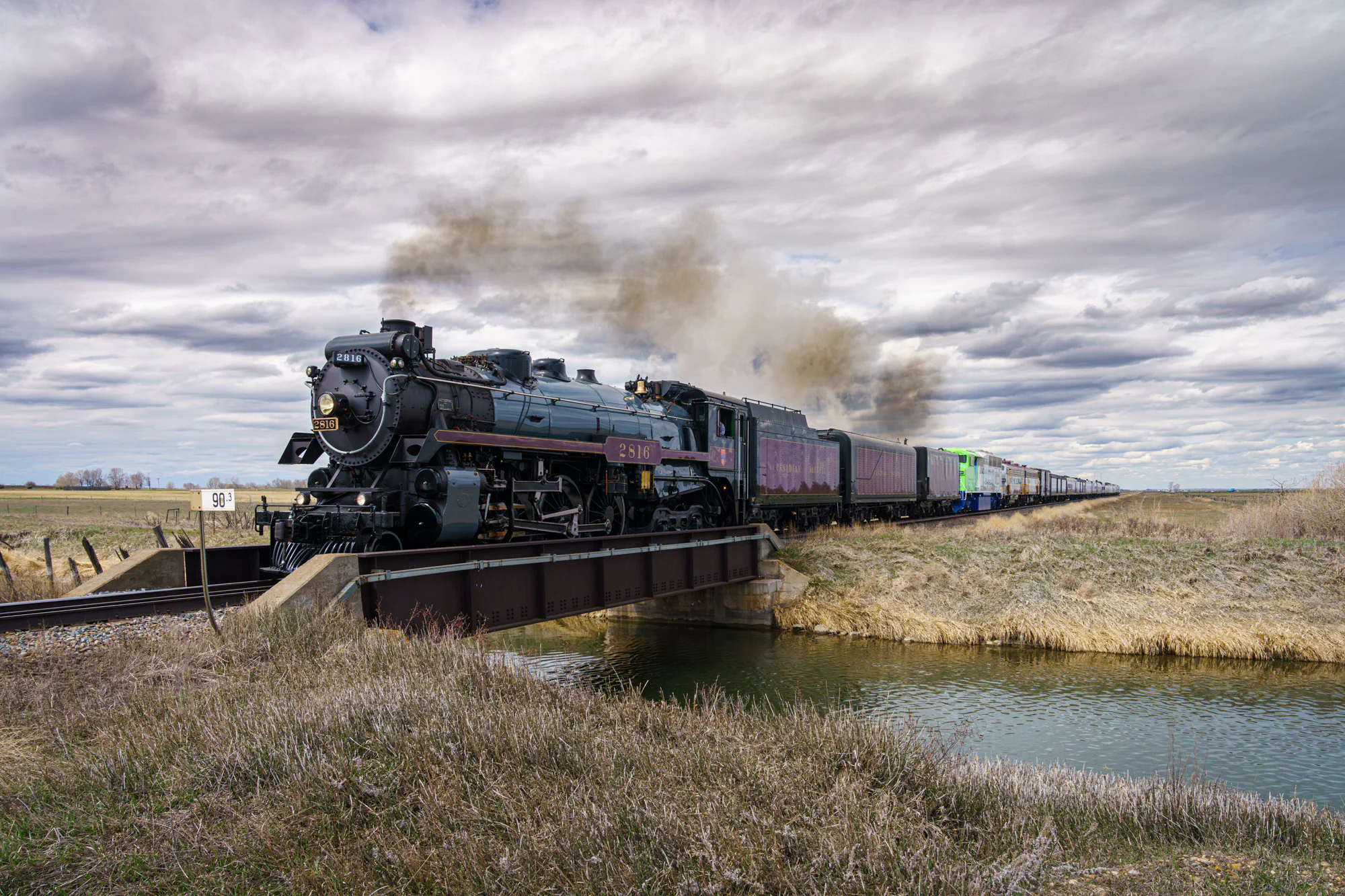
This was the end for me. I was still cold. The morning had chilled me to the bone and the adrenaline of the chase had started to wear off. From here, there were one, maybe two viable stops before the train went to Medicine Hat. It was a long way to go for little reward, and I had a pressing need to get back to Calgary, as Alex wanted to celebrate her last day of MRI practicum.
The pipeline inspector nodded, thanked us for giving him a reason to stay, and headed to his next stop. My single-serving friend headed on his way to the aqueduct for his next shot. Others, like the drone pilot, looked done as well, as there was less of a rush to pack up.
The coming down from a chase is always a bit rough. The sense of timing and urgency stretch out considerably, makings things seem to take quite a bit longer than normal. Worse still, I took Hwy 1 all the way back, and it’s definitely not the most direct route. But I had a smile nearly the whole way. It’s been a long time since I’d chased a train, and even though it’s not my favourite route, it’s still fun.
Maybe on the way back, 2816 will go over the Lethbridge Viaduct…
